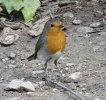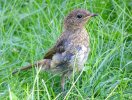Grahamby
New Member
- Time of past OR future Camino
- Le Puy - Spring 2023
My partner and I are thoroughly committed birdwatchers and nature-lovers. When she, my dad, and I decided to do the Camino Le Puy together, I was determined to devote a good portion of the experience to seeing as many birds as I could along the way. The region of France that the route from Le Puy en Velay to SJPP runs through is hardly a biodiversity hotspot. But, as I was reminded constantly, “this is not a birding trip!”, and birding the Camino was less about a single-minded focus on birding (impossible, of course), but adding birding to the daily routines that make up life on the path.
Birding has always given me a chance to slow down, observe, and tune in to the natural world that surrounds us everyday and I was really excited to see species in France that I was not familiar with. I was also keen to list my daily observations on eBird, a citizen-science platform that is helping record and map observations for scientists and conservation efforts. At least as far as eBird records are concerned, it is a relatively under-birded area, and while my daily lists were somewhat informal (“incidental” in the eBird parlance) given the daily walking distances involved, this minuscule contribution still felt satisfying.
Deciding to bird brought on some additional challenges, namely weight and comfort. Not bringing a full-on field guide was not an option for me. I am not familiar enough with European species to forgo a book, and prefer a book to looking at my phone. The lightest weight, back-pocket sized guide I could find was Lynx Editions’ Aves de Europa at 12.7 ounces. We also decided to leave the big (29.5 ounces) binoculars at home and looked for the best, lightest weight binoculars still suitable for birding. We ended up settling on the Leica Ultravid 10x25 at 9.4 ounces. I rigged these up through tiny carabiners on the shoulder straps of our packs to take the weight off our necks.
Because birds are most active in the morning, we started out slow and birded through mid-morning, always walking, but lingering when we wanted. My dad blazed ahead and we’d all meet up late-morning or midday. After lunch, it was time to put the binoculars away, or at least, until something unusual appeared. Birding had added benefits that dovetailed nicely with the needs dictated by the Camino: slow but steady pace, regular breaks with stretching, stopping regularly to take in the landscape. Sometimes feeling the pressure to push on was frustrating when searching for elusive birds (damned Black Woodpeckers), but with days and days of birding ahead in similar surroundings, it felt okay to let go and say “we’ll get ‘em tomorrow”. Turns out, there were a number of birds that I really wanted to see and never did (damned Bullfinches), but the next medieval abbey, plate of aligôt, glass of local armagnac, or cheerful reconnection with a fellow pilgrim more than made up them. Now I say, "we'll get 'em on the next Camino".
Walking and birding, day after day, over varied terrain, through different habitats, allowed for a feeling of connection to the landscape that can only be experienced at a walkers pace and with an attentive eye. Gradually descending from the high plateau of the Aubrac into the Lot Valley and beyond was seeing the season change from Winter to Spring in the matter of a single day. Of course, the species of birds also changed from higher altitudes to lower, the birdsong more varied and frequent as we came off the windy heathlands into full, blooming May.
Of course, none of this activity distracted us in the least from the enjoyment of the camaraderie, hospitality, architecture, food, sense of historical and spiritual being-ness, the trials and exhaustion that the Camino invokes. All of that is surely for another story. I will say if you want to experience the wilder aspects of walking the Camino, don’t hesitate to bring some lightweight binoculars and a field guide (or a bird identification app).
A list of the birds that were seen between Le Puy en Velay and Éauze:
Mute Swan
Mallard
Great Crested Grebe
Rock Pigeon
Common Wood Pigeon
Eurasian Collared Dove
Common Cuckoo
Alpine Swift
Common Swift
Eurasian Coot
Black-Headed Gull
Yellow-Legged Gull
Common Tern
Great Comorant
Gray Heron
Purple Heron
Great Egret
Little Egret
Cattle Egret
Red Kite
Black Kite
Common Buzzard
Eurasian Hoopoe
European Bee-eater
Eurasian Wryneck
Middle Spotted Woodpecker
Great Spotted Woodpecker
Eurasian Green Woodpecker
Eurasian Kestrel
Eurasian Golden Oriole
Eurasian Jay
Eurasian Magpie
Eurasian Jackdaw
Carrion Crow
Common Raven
Coal Tit
Crested Tit
Marsh Tit
Eurasian Blue Tit
Great Tit
Wood Lark
Eurasian Skylark
Zitting Cisticola
Melodious Warbler
Bank Swallow
Barn Swallow
Common House Martin
Western Bonelli’s Warbler
Willow Warbler
Common Chiffchaff
Long-tailed Tit
Eurasian Blackcap
Greater Whitethroat
Goldcrest
Common Firecrest
Eurasian Nuthatch
Eurasian Treecreeper
Short-toed Woodcreeper
Eurasian Wren
White-throated Dipper
European Starling
Mistle Thrush
Eurasian Blackbird
Fieldfare
Spotted Flycatcher
European Robin
Common Nightingale
European Pied Flycatcher
Common Redstart
Black Redstart
Whinchat
European Stonechat
Dunnock
House Sparrow
Gray Wagtail
White Wagtail
Meadow Pipit
Tree Pipit
Common Chaffinch
European Greenfinch
Eurasian Linnet
European Goldfinch
European Serin
Corn Bunting
Cirl Bunting
Yellowhammer
Birding has always given me a chance to slow down, observe, and tune in to the natural world that surrounds us everyday and I was really excited to see species in France that I was not familiar with. I was also keen to list my daily observations on eBird, a citizen-science platform that is helping record and map observations for scientists and conservation efforts. At least as far as eBird records are concerned, it is a relatively under-birded area, and while my daily lists were somewhat informal (“incidental” in the eBird parlance) given the daily walking distances involved, this minuscule contribution still felt satisfying.
Deciding to bird brought on some additional challenges, namely weight and comfort. Not bringing a full-on field guide was not an option for me. I am not familiar enough with European species to forgo a book, and prefer a book to looking at my phone. The lightest weight, back-pocket sized guide I could find was Lynx Editions’ Aves de Europa at 12.7 ounces. We also decided to leave the big (29.5 ounces) binoculars at home and looked for the best, lightest weight binoculars still suitable for birding. We ended up settling on the Leica Ultravid 10x25 at 9.4 ounces. I rigged these up through tiny carabiners on the shoulder straps of our packs to take the weight off our necks.
Because birds are most active in the morning, we started out slow and birded through mid-morning, always walking, but lingering when we wanted. My dad blazed ahead and we’d all meet up late-morning or midday. After lunch, it was time to put the binoculars away, or at least, until something unusual appeared. Birding had added benefits that dovetailed nicely with the needs dictated by the Camino: slow but steady pace, regular breaks with stretching, stopping regularly to take in the landscape. Sometimes feeling the pressure to push on was frustrating when searching for elusive birds (damned Black Woodpeckers), but with days and days of birding ahead in similar surroundings, it felt okay to let go and say “we’ll get ‘em tomorrow”. Turns out, there were a number of birds that I really wanted to see and never did (damned Bullfinches), but the next medieval abbey, plate of aligôt, glass of local armagnac, or cheerful reconnection with a fellow pilgrim more than made up them. Now I say, "we'll get 'em on the next Camino".
Walking and birding, day after day, over varied terrain, through different habitats, allowed for a feeling of connection to the landscape that can only be experienced at a walkers pace and with an attentive eye. Gradually descending from the high plateau of the Aubrac into the Lot Valley and beyond was seeing the season change from Winter to Spring in the matter of a single day. Of course, the species of birds also changed from higher altitudes to lower, the birdsong more varied and frequent as we came off the windy heathlands into full, blooming May.
Of course, none of this activity distracted us in the least from the enjoyment of the camaraderie, hospitality, architecture, food, sense of historical and spiritual being-ness, the trials and exhaustion that the Camino invokes. All of that is surely for another story. I will say if you want to experience the wilder aspects of walking the Camino, don’t hesitate to bring some lightweight binoculars and a field guide (or a bird identification app).
A list of the birds that were seen between Le Puy en Velay and Éauze:
Mute Swan
Mallard
Great Crested Grebe
Rock Pigeon
Common Wood Pigeon
Eurasian Collared Dove
Common Cuckoo
Alpine Swift
Common Swift
Eurasian Coot
Black-Headed Gull
Yellow-Legged Gull
Common Tern
Great Comorant
Gray Heron
Purple Heron
Great Egret
Little Egret
Cattle Egret
Red Kite
Black Kite
Common Buzzard
Eurasian Hoopoe
European Bee-eater
Eurasian Wryneck
Middle Spotted Woodpecker
Great Spotted Woodpecker
Eurasian Green Woodpecker
Eurasian Kestrel
Eurasian Golden Oriole
Eurasian Jay
Eurasian Magpie
Eurasian Jackdaw
Carrion Crow
Common Raven
Coal Tit
Crested Tit
Marsh Tit
Eurasian Blue Tit
Great Tit
Wood Lark
Eurasian Skylark
Zitting Cisticola
Melodious Warbler
Bank Swallow
Barn Swallow
Common House Martin
Western Bonelli’s Warbler
Willow Warbler
Common Chiffchaff
Long-tailed Tit
Eurasian Blackcap
Greater Whitethroat
Goldcrest
Common Firecrest
Eurasian Nuthatch
Eurasian Treecreeper
Short-toed Woodcreeper
Eurasian Wren
White-throated Dipper
European Starling
Mistle Thrush
Eurasian Blackbird
Fieldfare
Spotted Flycatcher
European Robin
Common Nightingale
European Pied Flycatcher
Common Redstart
Black Redstart
Whinchat
European Stonechat
Dunnock
House Sparrow
Gray Wagtail
White Wagtail
Meadow Pipit
Tree Pipit
Common Chaffinch
European Greenfinch
Eurasian Linnet
European Goldfinch
European Serin
Corn Bunting
Cirl Bunting
Yellowhammer
















